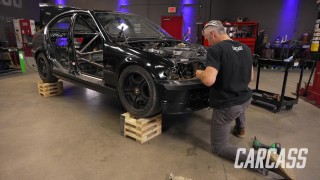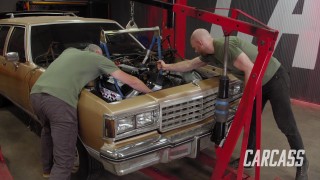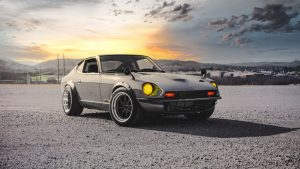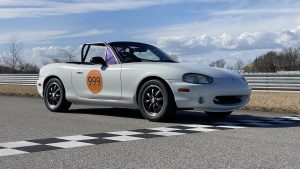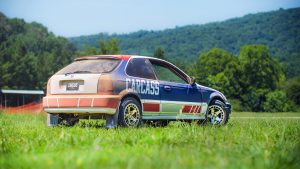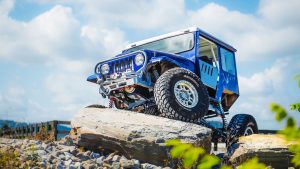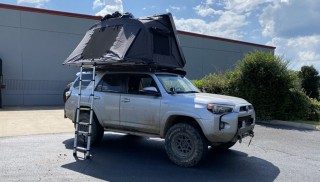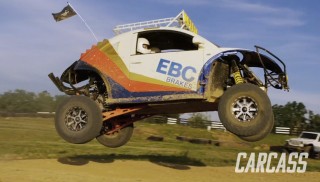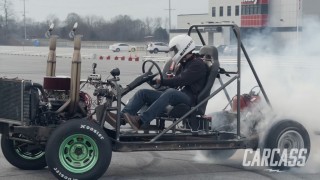More Square Body Tow Truck Episodes
Carcass Featured Projects
Carcass Builds
Want more content like this?
Join the PowerNation Email NewsletterParts Used In This Episode
Brothers Truck Parts
Dash Pad, Instrument Bezel, Gauges, Sport Steering Wheel Kit, Door Seals, Rubber Floor Mat
Matco Tools
20V+ Cordless Infinium Brushless Grinder
Matco Tools
MATCO Tools are the Official Tool Supplier to PowerNation
The Industrial Depot
Tools, Hardware, Shop Supplies
Tire Streets
Armstrong Tires Tru Trac
Episode Transcript
(Jimmy)>> You're watching Powernation!
(Jimmy)>> Today on Carcass we update the interior on our junkyard find square body.
(Jeremy)>> And we finish off the bed with a little fab and a new winch before hitting the road. [ MUSIC ] [ tires squealing ] [ MUSIC ]
(Jeremy)>> Our 1977 tow truck may not look like it's made much of a transformation but below that rusty exterior we've made a lot of progress.
(Jimmy)>> Our goal with this junkyard find is to give it new life and get it back out on the road but with safety in mind. There were big structural concerts with the rusted out frame on this truck, and the floors in the cab weren't looking much better.
(Jeremy)>> The only solution was to cut out the rust and reconstruct the rear end of the C-30 chassis. This took some careful measurements and a whole lot of welding, but it made for a sturdy platform to affix our updated suspension and that reliable axle.
(Jimmy)>> Awesome! With the frame in good condition we shifted our focus to the front end of the vehicle. We started with the power plant, removing the old 305 and replacing it with a 350 Chevy that makes 355 horsepower, easily doubling what we had in there before.
(Jeremy)>> With all that extra power we're gonna need this truck to drive straight, and all that play in the steering wheel wasn't going to cut it. So we upgraded the gearbox and the steering links up front.
(Jimmy)>> This left us with only the cab being untouched. We had a huge hole on the passenger side floor, and we even discovered that parts that had been replaced weren't done right. So we cut out a lot of the floor and called on Brothers Trucks to get some replacement pans for the cab.
(Jeremy)>> With about 250 rosette welds we were finally finished replacing the floor in the cab, and now it's time to call on Brothers Trucks one more time to finish off the interior. We're gonna pull out the old dash and replace it with a new update vinyl one. We'll throw in a new seat and a mat to make this thing a comfy work truck again. In the rear we'll drop in a new electric winch since the current one won't work with our upgraded transmission, and finally we'll patch up the giant holes we made in the bed to accommodate the chassis fix we made earlier. Now we've chosen to go with Brothers Trucks for our interior refresh because they house thousands of high quality classic GMC and Chevy truck parts from 1947 to 1987, and since our cab is a 1977 it seemed like a no brainer. Now the dash inside of our tow truck looks like it has been there its entire life. So we picked up a bunch of pieces to update the inside of our cab, like a new dash pad that's made of foam and a high quality vinyl, a new instrument bezel with a new lens so we can see our gauges again, and a whole bunch of new gauges so we can give our truck that factory fresh look. And finally we picked up a classic style steering wheel and some door seals to help keep the noise and the elements out. Now there's a couple pieces of the interior that we are gonna keep. So before we put anything together out here we're gonna ditch that worn out interior. [ drill buzzing ]
(Jeremy)>> To get to the instrument cluster we'll need to remove a few trim pieces including the instrument bezel. [ MUSIC ] [ drill buzzing ]
(Jeremy)>> The dash pad comes off next but this is one of the items that we'll come back to later. Now we can finally tackle the instrument cluster. A few screws hold it into place but on the back side we'll need to unhook the electrical connection, the oil pressure line, and the speedometer cable. Lastly we'll use a steering wheel puller to remove the steering wheel before giving our column a rattle can paint job.
(Jimmy)>> At the bench we're gonna go ahead and install the new goodies we got from Brothers Trucks. To gain access to our gauges we need to remove the front lens and the gauge bezel, tackling the speedometer first. This is a quick and easy replacement using all the existing hardware. In fact all these gauges are all easy to replace. Each one fits in the old location using the existing electrical tabs and original hardware. [ MUSIC ]
(Jeremy)>> With our gauge cluster wrapped up we're about ready to install everything back in the truck but there's one thing that we want to transfer over from the original dash. The original molding still looks great and we thought it would look good in our new vinyl dash that we got from Brothers Trucks. [ MUSIC ]
(Jimmy)>> Before we put anything back in the cab of our tow truck we're gonna freshen up the floor with some truck bed coating. This will go well with all the new trim pieces we'll be putting in here.
(Jeremy)>> Now we'll put everything back in the vehicle in the reverse order that it was taken out. That means the instrument cluster is first. We'll need to hook up the wiring harness, the speedometer cable, and we'll need to tighten down the oil pressure feed line. [ MUSIC ] [ drill buzzing ]
(Jeremy)>> Now the back of the dash needs to clip in. Oh like this. That was simple enough. Yeah that's it right there. [ MUSIC ]
(Jimmy)>> With our vinyl dash in place we can add the instrument bezel. It sits snug under the dash and against the lens.
(Jeremy)>> To finish off our dash we'll add a new steering wheel we picked up from Brothers Trucks. It's snugged down with a seven-eighths socket. Then we'll add the bracket for the horn button along with the cap.
(Jimmy)>> One of the last pieces is a rubber floor mat, which fits our floors nicely, and the last piece to finish off the cab a brand new bench seat we picked up from Summit Racing. There we go. [ MUSIC ]
(Jeremy)>> That finishes up our upgraded interior leaving us with a beautifully stitched seat, a renewed dash, plus an upgraded steering wheel and instrument cluster.
(Jimmy)>> Up next, we fix this mess out back... [ welder crackling ]
(Jimmy)>> ...with a little bit of fab work.
(Jimmy)>> If you remember back when we worked on the chassis we cut two huge holes in the back of the bed. The reason why we had to do that is because the rear spring shackles were actually welded to the back of the bed, and we didn't address it at first but now that the truck is almost done we have to fix it. So instead of just patching these holes or building a box to go around the shackle we're just gonna cut off these three leftover sections and completely rebuild the back end using a similar material, three-sixteenths steel. So the first step is cutting.
(Jeremy)>> To make this cut we're gonna use our Matco 20 volt grinder with a cutoff wheel. Now we aren't gonna immediately plunge the grinder into this three-sixteenths steel. We're gonna first score a line, creating a nice guide for us to follow when we come back around again with a final plunge cut.
(Jimmy)>> There are a few safety tips when making cuts like this. First we always orient the grinder so the disc is cutting away from us. In this case it's making the cut in a downward direction. This is not only safer but helps direct sparks away from you. Second, when cutting metal or any material for that matter you need to be aware of stresses in the material. When things separate that's a good thing, but when stresses cause your material to pinch your cutting disc, that's where you can run into trouble. [ saw buzzing ]
(Jimmy)>> Lastly you should always watch where your feet are. There's nothing worse than a broken toe from a hunk of metal that slips from your hand as you set it down.
(Jeremy)>> With safety aside all we need to do is clean up our edges with a flap disc, and we're left with a clean plate to form our back end. We're gonna use three-sixteenths steel to build out this rear end, and that starts with cutting a 48 by 17 inch piece.
(Jimmy)>> The first piece is what we'll build everything else off of. So to secure it we'll tack it to the frame but we're placing the tacks in an easy location for the future owner to easily cut away later.
(Jeremy)>> With that in place we can cut out the left piece. With the same three-sixteenths steel plate we'll cut a 15 by 17 inch piece and fit it to the driver's side. [ welder crackling ]
(Jeremy)>> With that tacked in we can tackle the passenger side. This will receive a number of tacks as well. [ welder crackling ]
(Jimmy)>> Now that we're done with the main panels it's time to cap off the top with some smaller pieces to make it look complete. We're gonna make the top out of three separate pieces. One for each end and one in the middle. These pieces are gonna be kinda irregular in shape. So it'll take some time and test fitting to get it right. So to start we're gonna make some templates out of cardboard. [ MUSIC ] We traced our cardboard shapes on some more three-sixteenths steel and we cut them out at the band saw cutting on the inside edge of the line. With it cut out we can test fit our piece and tack it in. [ welder crackling ]
(Jeremy)>> Now projects like this don't always line up perfectly, and some brute force is expect to close some minor gaps. Just be mindful of the material that you're using to help do this. You don't want to melt something or have something catch on fire from the heat of the weld. [ welder crackling ] [ MUSIC ]
(Jimmy)>> With our tougher pieces out of the way we have one more piece that's gonna be about 39 and seven-eighths inches long and it'll pretty much be a rectangle, but because of this edge I did a free hand cut on it'll take some grinding to get it to fit just right, and also while I'm doing that I'm gonna show you a little grinding trick to help you with butt welds. [ torch hissing ]
(Jimmy)>> We cut out a 39 by three and a quarter inch piece of three-sixteenths steel, cleaning up the edge with a grinder. [ MUSIC ]
(Jeremy)>> Got to take a little bit there. [ MUSIC ]
(Jimmy)>> Knowing where we need to trim back our piece to match the profile of the bed, we'll grind back to our line and give it another test fit. That looks pretty good. So this plate is fitting pretty well now but there's one thing left that I have to do. I'm gonna put a chamfer on all the edges where there's gonna be a butt weld, and there's a reason for that. Once you weld over that it'll allow the weld to lay a little bit flatter and it'll look a lot cleaner. [ grinder buzzing ] [ welder crackling ]
(Jeremy)>> Something to note while you're welding. If you're using magnets like we are here you're gonna want to remove them when you're welding near them. These things like to disrupt the arc and give you all kinds of headaches.
(Jimmy)>> Let me show you why we put a bevel on the pieces in a butt joint, and to first illustrate that I'll show you an open corner joint. An open corner joint is nice because there's a lot of area for the filler material to go and it gives us a nice line to follow when we're welding, but with a normal butt joint we don't really have that benefit cause when you try to weld it the filler material kinda builds up on top of it and it doesn't look that great. So when we put a bevel on it it gives us a nice line to follow and it gives a good space for the filler material to go. You'll notice as we weld up this butt joint the filler material caps off the beveled area nicely, leaving a flatter profile than if we were just to butt the two pieces together.
(Jeremy)>> This part of the project is nearly done, and we have a ton of welding to do, merging each gap with good strong welds. [ welder crackling ]
(Jimmy)>> Rebuilding the chassis of this truck was necessary and it left us with a less than ideal situation, but now with the back of this truck closed off we're almost ready to tow some cars.
(Jeremy)>> Coming up, we yank out the old mechanical winch and replace it with an electric variant.
[ MUSIC ]
(Jimmy)>> This truck is almost ready to hit the road again but we have to address one important feature to make this truck fully functional and that's the winch system. The original winch on this truck was powered a p-t-o, or power take off shaft, coming off the manual transmission. Since we swapped over to an automatic it doesn't have that feature. So what we're gonna do is replace this winch with an electric winch, which is nice because all we have to worry about is a battery.
(Jeremy)>> The original mechanical winch was controlled by these two levers in the back of the truck. Jimmy and I love the fact that they're still back. It makes this truck pretty nostalgic, but what we want to do is find a way to use these two levers to control our electric winch. Now we've got a little bit of investigative work to do before we figure this all out. [ MUSIC ] Alright so red and white should put the winch out. [ MUSIC ] [ compressor humming ]
(Jeremy)>> Alright so this is what we have figured out. If we jump the red and the white the winch goes out. If we jump the red and the green the winch comes back in.
(Jimmy)>> And if we flip this switch and jump the white and the blue the compressor turns on.
(Jeremy)>> Just like that! Now all we've got to do is figure out how to put this in the truck. [ MUSIC ] [ drill buzzing ] [ MUSIC ]
(Jeremy)>> That thing is so heavy! [ metal clanging ]
(Jeremy)>> Can you grab that side, you good there?
(Jimmy)>> Yeah I think so.
(Jeremy)>> Come on He-Man! [ MUSIC ] Holy cow! With our old winch gone we've got to come up with a way to install our new winch. That's gonna be as simple as a couple of plates and a couple of gussets. So what we're gonna do is bolt these two brackets to our new winch. We'll weld them on to the channel that the old winch came off of, and then we're just gonna weld on a couple of gussets for some strength. [ drill buzzing ] [ MUSIC ] [ welder crackling ] [ MUSIC ] [ welder crackling ] [ MUSIC ]
(Jeremy)>> To make the original levers work in the back of the tow truck we're gonna be using a set of switches that we got from AutoZone. Now these Duralast switches are a basic on and off switch. So when we push the button the winch will engage. Now these switches have a protective rubber coating on the back and a waterproof cap, and they're reliable even under the harshest condition. So these switches will work great in the back of our tow truck when they're exposed to the elements. [ welder crackling ] [ MUSIC ]
(Jimmy)>> Check this out. This thing's gonna be functional and it's gonna look cool too.
(Jeremy)>> Dude nice job painting that to match the truck. That's awesome! [ MUSIC ]
(Jimmy)>> Alright hit it.
(Jeremy)>> Check this out. We've got a fully functional tow truck again, and we're almost ready to hit the road.
(Jimmy)>> That's a nice piece.
(Jeremy)>> After the break we hit the road in our square body junkyard rescue.
(Jimmy)>> And we're bound to get our hands dirty!
(Jimmy)>> Our tow truck is just about ready to hit the road but there's one little change that both Jeremy and I wanted to make to the patina'ed exterior. We wanted to strip down the wheels to bare metal and give it a little rattle can refresh to make the outside look like they'd just came fresh from the factory.
(Jeremy)>> And the tires that we chose to wrap them with are an Armstrong True Track HT that we got from Tire Streets. They have a special engineered tread design that provides greater towing ability on the highway. The curved profile of the tread also increases rigidity, and there's a noise blocking bar on the tire's shoulder that delays premature wear and results in a quieter ride. [ MUSIC ] Wow look at that thing.
(Jimmy)>> You ready to go?
(Jeremy)>> Yeah but if it's cool with you I think I'm gonna drive this time.
(Jimmy)>> That's fine.
(Jeremy)>> And I totally claimed us a parking spot.
(Jimmy)>> That's neat! [ MUSIC ]
(Jeremy)>> Well the truck is done and we're actually driving it now. It drives out good. It's got way more power than it did before, not that would could really base it off of much cause we drove it onto the trailer. I like it!
(Jimmy)>> Yeah me too! It's safe.
(Jeremy)>> Safer than it was before.
(Jimmy)>> Obviously this truck isn't worth fully restoring but if you want to make it drivable, the chassis stuff and putting floors in it, that's really as far as you want to take it. Otherwise it's too much time investment for what you're gonna get out of it.
(Jeremy)>> Really the truck, for what it was, was worth putting some time and effort into to get it back on the road but to make it perfect.
(Jimmy)>> Just buy a better truck?
(Jeremy)>> You just buy a better truck. [ MUSIC ] I love the build. I love the idea that we pulled it out of the junkyard. Resurrected it if you will. [ MUSIC ] Well the truck made it back with flying colors. Who is parked in our spot?
(Jimmy)>> I believe that's mister Tommy.
(Jeremy)>> We can take care of that. We've got a tow truck.
(Jimmy)>> Come on back. [ MUSIC ] Crank it. [ MUSIC ] We're good! [ MUSIC ] Tow truck, pretty convenient. [ MUSIC ]
(Jeremy)>> It's our parking spot now.
(Jimmy)>> I guess yeah. There's a sign there isn't there? For more builds like this check out Powernation TV dot com.
Show Full Transcript
(Jimmy)>> Today on Carcass we update the interior on our junkyard find square body.
(Jeremy)>> And we finish off the bed with a little fab and a new winch before hitting the road. [ MUSIC ] [ tires squealing ] [ MUSIC ]
(Jeremy)>> Our 1977 tow truck may not look like it's made much of a transformation but below that rusty exterior we've made a lot of progress.
(Jimmy)>> Our goal with this junkyard find is to give it new life and get it back out on the road but with safety in mind. There were big structural concerts with the rusted out frame on this truck, and the floors in the cab weren't looking much better.
(Jeremy)>> The only solution was to cut out the rust and reconstruct the rear end of the C-30 chassis. This took some careful measurements and a whole lot of welding, but it made for a sturdy platform to affix our updated suspension and that reliable axle.
(Jimmy)>> Awesome! With the frame in good condition we shifted our focus to the front end of the vehicle. We started with the power plant, removing the old 305 and replacing it with a 350 Chevy that makes 355 horsepower, easily doubling what we had in there before.
(Jeremy)>> With all that extra power we're gonna need this truck to drive straight, and all that play in the steering wheel wasn't going to cut it. So we upgraded the gearbox and the steering links up front.
(Jimmy)>> This left us with only the cab being untouched. We had a huge hole on the passenger side floor, and we even discovered that parts that had been replaced weren't done right. So we cut out a lot of the floor and called on Brothers Trucks to get some replacement pans for the cab.
(Jeremy)>> With about 250 rosette welds we were finally finished replacing the floor in the cab, and now it's time to call on Brothers Trucks one more time to finish off the interior. We're gonna pull out the old dash and replace it with a new update vinyl one. We'll throw in a new seat and a mat to make this thing a comfy work truck again. In the rear we'll drop in a new electric winch since the current one won't work with our upgraded transmission, and finally we'll patch up the giant holes we made in the bed to accommodate the chassis fix we made earlier. Now we've chosen to go with Brothers Trucks for our interior refresh because they house thousands of high quality classic GMC and Chevy truck parts from 1947 to 1987, and since our cab is a 1977 it seemed like a no brainer. Now the dash inside of our tow truck looks like it has been there its entire life. So we picked up a bunch of pieces to update the inside of our cab, like a new dash pad that's made of foam and a high quality vinyl, a new instrument bezel with a new lens so we can see our gauges again, and a whole bunch of new gauges so we can give our truck that factory fresh look. And finally we picked up a classic style steering wheel and some door seals to help keep the noise and the elements out. Now there's a couple pieces of the interior that we are gonna keep. So before we put anything together out here we're gonna ditch that worn out interior. [ drill buzzing ]
(Jeremy)>> To get to the instrument cluster we'll need to remove a few trim pieces including the instrument bezel. [ MUSIC ] [ drill buzzing ]
(Jeremy)>> The dash pad comes off next but this is one of the items that we'll come back to later. Now we can finally tackle the instrument cluster. A few screws hold it into place but on the back side we'll need to unhook the electrical connection, the oil pressure line, and the speedometer cable. Lastly we'll use a steering wheel puller to remove the steering wheel before giving our column a rattle can paint job.
(Jimmy)>> At the bench we're gonna go ahead and install the new goodies we got from Brothers Trucks. To gain access to our gauges we need to remove the front lens and the gauge bezel, tackling the speedometer first. This is a quick and easy replacement using all the existing hardware. In fact all these gauges are all easy to replace. Each one fits in the old location using the existing electrical tabs and original hardware. [ MUSIC ]
(Jeremy)>> With our gauge cluster wrapped up we're about ready to install everything back in the truck but there's one thing that we want to transfer over from the original dash. The original molding still looks great and we thought it would look good in our new vinyl dash that we got from Brothers Trucks. [ MUSIC ]
(Jimmy)>> Before we put anything back in the cab of our tow truck we're gonna freshen up the floor with some truck bed coating. This will go well with all the new trim pieces we'll be putting in here.
(Jeremy)>> Now we'll put everything back in the vehicle in the reverse order that it was taken out. That means the instrument cluster is first. We'll need to hook up the wiring harness, the speedometer cable, and we'll need to tighten down the oil pressure feed line. [ MUSIC ] [ drill buzzing ]
(Jeremy)>> Now the back of the dash needs to clip in. Oh like this. That was simple enough. Yeah that's it right there. [ MUSIC ]
(Jimmy)>> With our vinyl dash in place we can add the instrument bezel. It sits snug under the dash and against the lens.
(Jeremy)>> To finish off our dash we'll add a new steering wheel we picked up from Brothers Trucks. It's snugged down with a seven-eighths socket. Then we'll add the bracket for the horn button along with the cap.
(Jimmy)>> One of the last pieces is a rubber floor mat, which fits our floors nicely, and the last piece to finish off the cab a brand new bench seat we picked up from Summit Racing. There we go. [ MUSIC ]
(Jeremy)>> That finishes up our upgraded interior leaving us with a beautifully stitched seat, a renewed dash, plus an upgraded steering wheel and instrument cluster.
(Jimmy)>> Up next, we fix this mess out back... [ welder crackling ]
(Jimmy)>> ...with a little bit of fab work.
(Jimmy)>> If you remember back when we worked on the chassis we cut two huge holes in the back of the bed. The reason why we had to do that is because the rear spring shackles were actually welded to the back of the bed, and we didn't address it at first but now that the truck is almost done we have to fix it. So instead of just patching these holes or building a box to go around the shackle we're just gonna cut off these three leftover sections and completely rebuild the back end using a similar material, three-sixteenths steel. So the first step is cutting.
(Jeremy)>> To make this cut we're gonna use our Matco 20 volt grinder with a cutoff wheel. Now we aren't gonna immediately plunge the grinder into this three-sixteenths steel. We're gonna first score a line, creating a nice guide for us to follow when we come back around again with a final plunge cut.
(Jimmy)>> There are a few safety tips when making cuts like this. First we always orient the grinder so the disc is cutting away from us. In this case it's making the cut in a downward direction. This is not only safer but helps direct sparks away from you. Second, when cutting metal or any material for that matter you need to be aware of stresses in the material. When things separate that's a good thing, but when stresses cause your material to pinch your cutting disc, that's where you can run into trouble. [ saw buzzing ]
(Jimmy)>> Lastly you should always watch where your feet are. There's nothing worse than a broken toe from a hunk of metal that slips from your hand as you set it down.
(Jeremy)>> With safety aside all we need to do is clean up our edges with a flap disc, and we're left with a clean plate to form our back end. We're gonna use three-sixteenths steel to build out this rear end, and that starts with cutting a 48 by 17 inch piece.
(Jimmy)>> The first piece is what we'll build everything else off of. So to secure it we'll tack it to the frame but we're placing the tacks in an easy location for the future owner to easily cut away later.
(Jeremy)>> With that in place we can cut out the left piece. With the same three-sixteenths steel plate we'll cut a 15 by 17 inch piece and fit it to the driver's side. [ welder crackling ]
(Jeremy)>> With that tacked in we can tackle the passenger side. This will receive a number of tacks as well. [ welder crackling ]
(Jimmy)>> Now that we're done with the main panels it's time to cap off the top with some smaller pieces to make it look complete. We're gonna make the top out of three separate pieces. One for each end and one in the middle. These pieces are gonna be kinda irregular in shape. So it'll take some time and test fitting to get it right. So to start we're gonna make some templates out of cardboard. [ MUSIC ] We traced our cardboard shapes on some more three-sixteenths steel and we cut them out at the band saw cutting on the inside edge of the line. With it cut out we can test fit our piece and tack it in. [ welder crackling ]
(Jeremy)>> Now projects like this don't always line up perfectly, and some brute force is expect to close some minor gaps. Just be mindful of the material that you're using to help do this. You don't want to melt something or have something catch on fire from the heat of the weld. [ welder crackling ] [ MUSIC ]
(Jimmy)>> With our tougher pieces out of the way we have one more piece that's gonna be about 39 and seven-eighths inches long and it'll pretty much be a rectangle, but because of this edge I did a free hand cut on it'll take some grinding to get it to fit just right, and also while I'm doing that I'm gonna show you a little grinding trick to help you with butt welds. [ torch hissing ]
(Jimmy)>> We cut out a 39 by three and a quarter inch piece of three-sixteenths steel, cleaning up the edge with a grinder. [ MUSIC ]
(Jeremy)>> Got to take a little bit there. [ MUSIC ]
(Jimmy)>> Knowing where we need to trim back our piece to match the profile of the bed, we'll grind back to our line and give it another test fit. That looks pretty good. So this plate is fitting pretty well now but there's one thing left that I have to do. I'm gonna put a chamfer on all the edges where there's gonna be a butt weld, and there's a reason for that. Once you weld over that it'll allow the weld to lay a little bit flatter and it'll look a lot cleaner. [ grinder buzzing ] [ welder crackling ]
(Jeremy)>> Something to note while you're welding. If you're using magnets like we are here you're gonna want to remove them when you're welding near them. These things like to disrupt the arc and give you all kinds of headaches.
(Jimmy)>> Let me show you why we put a bevel on the pieces in a butt joint, and to first illustrate that I'll show you an open corner joint. An open corner joint is nice because there's a lot of area for the filler material to go and it gives us a nice line to follow when we're welding, but with a normal butt joint we don't really have that benefit cause when you try to weld it the filler material kinda builds up on top of it and it doesn't look that great. So when we put a bevel on it it gives us a nice line to follow and it gives a good space for the filler material to go. You'll notice as we weld up this butt joint the filler material caps off the beveled area nicely, leaving a flatter profile than if we were just to butt the two pieces together.
(Jeremy)>> This part of the project is nearly done, and we have a ton of welding to do, merging each gap with good strong welds. [ welder crackling ]
(Jimmy)>> Rebuilding the chassis of this truck was necessary and it left us with a less than ideal situation, but now with the back of this truck closed off we're almost ready to tow some cars.
(Jeremy)>> Coming up, we yank out the old mechanical winch and replace it with an electric variant.
[ MUSIC ]
(Jimmy)>> This truck is almost ready to hit the road again but we have to address one important feature to make this truck fully functional and that's the winch system. The original winch on this truck was powered a p-t-o, or power take off shaft, coming off the manual transmission. Since we swapped over to an automatic it doesn't have that feature. So what we're gonna do is replace this winch with an electric winch, which is nice because all we have to worry about is a battery.
(Jeremy)>> The original mechanical winch was controlled by these two levers in the back of the truck. Jimmy and I love the fact that they're still back. It makes this truck pretty nostalgic, but what we want to do is find a way to use these two levers to control our electric winch. Now we've got a little bit of investigative work to do before we figure this all out. [ MUSIC ] Alright so red and white should put the winch out. [ MUSIC ] [ compressor humming ]
(Jeremy)>> Alright so this is what we have figured out. If we jump the red and the white the winch goes out. If we jump the red and the green the winch comes back in.
(Jimmy)>> And if we flip this switch and jump the white and the blue the compressor turns on.
(Jeremy)>> Just like that! Now all we've got to do is figure out how to put this in the truck. [ MUSIC ] [ drill buzzing ] [ MUSIC ]
(Jeremy)>> That thing is so heavy! [ metal clanging ]
(Jeremy)>> Can you grab that side, you good there?
(Jimmy)>> Yeah I think so.
(Jeremy)>> Come on He-Man! [ MUSIC ] Holy cow! With our old winch gone we've got to come up with a way to install our new winch. That's gonna be as simple as a couple of plates and a couple of gussets. So what we're gonna do is bolt these two brackets to our new winch. We'll weld them on to the channel that the old winch came off of, and then we're just gonna weld on a couple of gussets for some strength. [ drill buzzing ] [ MUSIC ] [ welder crackling ] [ MUSIC ] [ welder crackling ] [ MUSIC ]
(Jeremy)>> To make the original levers work in the back of the tow truck we're gonna be using a set of switches that we got from AutoZone. Now these Duralast switches are a basic on and off switch. So when we push the button the winch will engage. Now these switches have a protective rubber coating on the back and a waterproof cap, and they're reliable even under the harshest condition. So these switches will work great in the back of our tow truck when they're exposed to the elements. [ welder crackling ] [ MUSIC ]
(Jimmy)>> Check this out. This thing's gonna be functional and it's gonna look cool too.
(Jeremy)>> Dude nice job painting that to match the truck. That's awesome! [ MUSIC ]
(Jimmy)>> Alright hit it.
(Jeremy)>> Check this out. We've got a fully functional tow truck again, and we're almost ready to hit the road.
(Jimmy)>> That's a nice piece.
(Jeremy)>> After the break we hit the road in our square body junkyard rescue.
(Jimmy)>> And we're bound to get our hands dirty!
(Jimmy)>> Our tow truck is just about ready to hit the road but there's one little change that both Jeremy and I wanted to make to the patina'ed exterior. We wanted to strip down the wheels to bare metal and give it a little rattle can refresh to make the outside look like they'd just came fresh from the factory.
(Jeremy)>> And the tires that we chose to wrap them with are an Armstrong True Track HT that we got from Tire Streets. They have a special engineered tread design that provides greater towing ability on the highway. The curved profile of the tread also increases rigidity, and there's a noise blocking bar on the tire's shoulder that delays premature wear and results in a quieter ride. [ MUSIC ] Wow look at that thing.
(Jimmy)>> You ready to go?
(Jeremy)>> Yeah but if it's cool with you I think I'm gonna drive this time.
(Jimmy)>> That's fine.
(Jeremy)>> And I totally claimed us a parking spot.
(Jimmy)>> That's neat! [ MUSIC ]
(Jeremy)>> Well the truck is done and we're actually driving it now. It drives out good. It's got way more power than it did before, not that would could really base it off of much cause we drove it onto the trailer. I like it!
(Jimmy)>> Yeah me too! It's safe.
(Jeremy)>> Safer than it was before.
(Jimmy)>> Obviously this truck isn't worth fully restoring but if you want to make it drivable, the chassis stuff and putting floors in it, that's really as far as you want to take it. Otherwise it's too much time investment for what you're gonna get out of it.
(Jeremy)>> Really the truck, for what it was, was worth putting some time and effort into to get it back on the road but to make it perfect.
(Jimmy)>> Just buy a better truck?
(Jeremy)>> You just buy a better truck. [ MUSIC ] I love the build. I love the idea that we pulled it out of the junkyard. Resurrected it if you will. [ MUSIC ] Well the truck made it back with flying colors. Who is parked in our spot?
(Jimmy)>> I believe that's mister Tommy.
(Jeremy)>> We can take care of that. We've got a tow truck.
(Jimmy)>> Come on back. [ MUSIC ] Crank it. [ MUSIC ] We're good! [ MUSIC ] Tow truck, pretty convenient. [ MUSIC ]
(Jeremy)>> It's our parking spot now.
(Jimmy)>> I guess yeah. There's a sign there isn't there? For more builds like this check out Powernation TV dot com.







